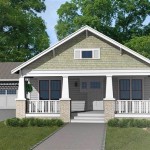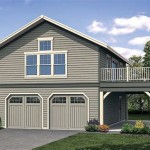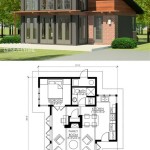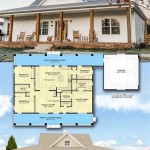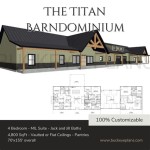Modern House Plans for Sloped Lots: Integrating Design with Topography
Building a home on a sloped lot presents unique challenges and opportunities. While a flat, readily buildable lot might seem ideal, sloped properties often offer stunning views, enhanced privacy, and the potential for creative architectural designs that blend seamlessly with the natural landscape. Modern house plans specifically designed for sloped lots address these challenges and capitalize on the advantages, resulting in aesthetically pleasing and functional living spaces.
Successfully integrating a home with a sloping terrain requires careful planning and consideration of various factors, including soil stability, drainage, accessibility, and building codes. Modern architecture emphasizes clean lines, open spaces, and a connection to the outdoors, principles that can be beautifully realized on a sloped site with the right design approach. This article will explore key aspects of modern house plans for sloped lots, highlighting essential design considerations and common architectural strategies.
Understanding the Landscape: Site Analysis and Preparation
Before even considering specific house plans, a thorough site analysis is paramount. This involves a detailed assessment of the lot's topography, soil composition, existing vegetation, drainage patterns, and potential access points. A qualified geotechnical engineer should conduct a soil test to determine the load-bearing capacity of the ground and identify any potential hazards, such as unstable soil or the presence of underground water sources. The results of the soil test will inform the foundation design and any necessary site stabilization measures.
Topographic surveys are crucial for understanding the slope's contours and identifying optimal building locations. This data will help architects and engineers visualize how the house will interact with the land and design accordingly. Existing vegetation should also be carefully assessed. Mature trees can provide shade, enhance privacy, and add to the aesthetic appeal of the property. Preserving these existing features whenever possible is a sustainable and cost-effective approach. However, it's important to consider the potential impact of tree roots on the foundation and ensure that proper drainage is in place to prevent water damage.
Site preparation may involve excavation, grading, and retaining wall construction. Excavation is necessary to create a level building platform and establish the foundation. Grading involves reshaping the land to improve drainage and accessibility. Retaining walls are structural elements designed to hold back soil and prevent erosion. They are often used to create level terraces on sloped sites, providing usable outdoor spaces and enhancing the overall aesthetic appeal of the property. The design and construction of retaining walls require careful consideration of soil pressure, drainage, and structural integrity.
Designing with the Slope: Architectural Strategies for Integration
Modern house plans for sloped lots employ a variety of architectural strategies to seamlessly integrate the house with the terrain. One common approach is to utilize a stepped foundation, where the foundation is built in a series of levels that follow the natural contours of the slope. This minimizes the amount of excavation required and allows the house to blend more naturally with the landscape. Another popular strategy is to incorporate a walk-out basement, where one or more walls of the basement are exposed to the exterior, providing direct access to the backyard. This creates additional living space and takes advantage of the natural slope.
Cantilevered designs are also frequently used in modern house plans for sloped lots. A cantilever is a structural element that extends horizontally beyond its support, creating an overhang. This can be used to create sheltered outdoor spaces, provide dramatic views, and reduce the footprint of the house on the land. However, cantilevered designs require careful engineering and may be more expensive to construct.
Daylighting is a crucial consideration in the design of sloped homes. Maximizing natural light can significantly improve the comfort and livability of the interior spaces. Large windows, skylights, and strategically placed openings can bring natural light into even the lowest levels of the house. The orientation of the house on the lot should also be carefully considered to take advantage of sunlight and minimize heat gain. In colder climates, orienting the house towards the south can maximize solar gain and reduce heating costs. In warmer climates, shading devices such as overhangs and awnings can help reduce heat gain and keep the house cooler.
The design of the roof is also an important consideration. A flat roof can be a modern and aesthetically pleasing choice, but it requires careful attention to drainage to prevent water damage. A sloped roof can be more effective at shedding water and snow, and it can also provide additional attic space. Green roofs, which are covered with vegetation, are another option that can improve insulation, reduce stormwater runoff, and enhance the aesthetic appeal of the house. Regardless of the roof design, it's important to ensure that it is properly insulated and ventilated to prevent moisture problems.
Material Selection and Sustainability: Building for the Long Term
The choice of building materials is critical for the durability, energy efficiency, and aesthetic appeal of a modern house on a sloped lot. Durable and weather-resistant materials are essential, especially for the exterior cladding. Common choices include concrete, stone, brick, wood siding, and metal panels. Concrete is a strong and durable material that can be used for foundations, walls, and floors. Stone is a natural and aesthetically pleasing material that can be used for walls, patios, and walkways. Wood siding is a classic choice that can be stained or painted to complement the surrounding landscape. Metal panels are a modern and low-maintenance option that can add a sleek and contemporary look to the house.
Sustainability should be a key consideration in the design and construction of a modern house on a sloped lot. Energy-efficient windows and doors, proper insulation, and high-efficiency heating and cooling systems can significantly reduce energy consumption and lower utility bills. Solar panels can be installed on the roof to generate electricity and further reduce reliance on fossil fuels. Water conservation measures, such as low-flow toilets and showerheads, can also help reduce water consumption.
The use of sustainable building materials is also important. Reclaimed wood, recycled concrete, and other eco-friendly materials can reduce the environmental impact of the construction process. Proper site management is crucial to minimize soil erosion and protect water quality during construction. Implementing erosion control measures, such as silt fences and sediment traps, can prevent sediment from entering waterways. Properly disposing of construction waste and recycling materials whenever possible can further reduce the environmental impact of the project.
Accessibility is another important consideration, especially for homeowners who plan to age in place. Ramps and elevators can be incorporated into the design to provide access to all levels of the house. Wider doorways and hallways can accommodate wheelchairs and other mobility devices. Grab bars can be installed in bathrooms and other areas to provide added safety and support. Universal design principles, which aim to create spaces that are accessible to people of all ages and abilities, should be considered throughout the design process.
Landscaping plays a critical role in integrating the house with the surrounding landscape. Native plants are a great choice for sloped lots, as they are adapted to the local climate and require less maintenance. They also provide habitat for wildlife and contribute to the biodiversity of the area. Terracing can be used to create level planting areas and prevent soil erosion. Retaining walls can also be used to create raised garden beds and add visual interest to the landscape. Proper drainage is essential to prevent water from pooling around the foundation and damaging the house. A well-designed landscape can enhance the aesthetic appeal of the house, provide usable outdoor spaces, and contribute to the overall sustainability of the property.
Building on a sloped lot requires careful planning, expert design, and meticulous execution. By understanding the challenges and opportunities that these unique sites present, homeowners can create stunning and functional living spaces that seamlessly integrate with the natural landscape. Modern house plans for sloped lots offer a range of architectural strategies and design solutions that can transform a challenging building site into a beautiful and sustainable home.

Modern House Plans For Sloped Lots Fresh 29 Best Steep Slope Images On Sloping Lot Plan

Sloped Lot House Plans With Walkout Basements At Dream Home Source Unique Modern Architecture

Modern House Plan Sloping Lot Contemporary Style 5590 Vista

Plan 51696 Traditional Hillside Home With 1736 Sq Ft 3 Be

Looking For The Perfect Affordable Cottage With A Large Covered Balcony Plan 1143

Sloped Lot House Plans Down Slope The Designers

Ocho House Sloping Lot Plan Slope Hillside

Home Plan Ch507

Sloping Lot Home Design In South

The Best House Plans For Sloped Lots And Narrow Houseplans Blog Com


